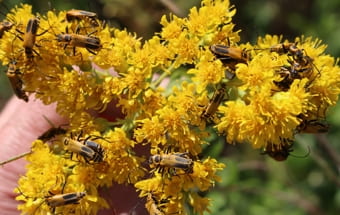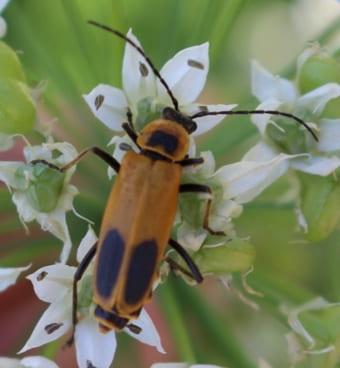–by Raymond Cloyd — Horticultural Entomologist
Goldenrod soldier beetle, Chauliognathus pennsylvanicus, adults are feeding on goldenrod (Solidago spp.) (Figure 1) as well as other flowering plants. Adults can be seen feeding and mating simultaneously. The goldenrod soldier beetle is common throughout most of Kansas.

Figure 1. Goldenrod soldier beetle adults feeding goldenrod flowers (Raymond Cloyd, KSU)
Adults are about 1/2 of an inch long, elongated, and orange with two dark bands on the base of the forewings (elytra) and thorax (middle section) (Figure 2). In general, adults are present from August through September. Adult soldier beetles feed on the pollen and nectar of flowers. In addition, they are predators and will consume insects such as aphids and caterpillars. Flowers are a great place for the male and female soldier beetle adults to meet and then mate (Figure 3). Soldier beetle adults do not cause plant damage. Adults may occasionally enter homes, but they are rarely a concern. The best way to deal with adults in the home is to sweep, hand-pick, or vacuum.

Figure 2. Goldenrod soldier beetle adult (Raymond Cloyd, KSU)

Figure 3. Goldenrod soldier beetle adults mating (Raymond Cloyd, KSU)
Adult females lay clusters of eggs in the soil. The larva that emerges (eclose) from eggs are dark-colored, slender, and covered with small dense hairs or bristles, which gives the larva a velvety appearance. The larva resides in soil feeding on grasshopper eggs. Sometimes, the larva will emerge from the soil and feed on soft-bodied insects and small caterpillars.